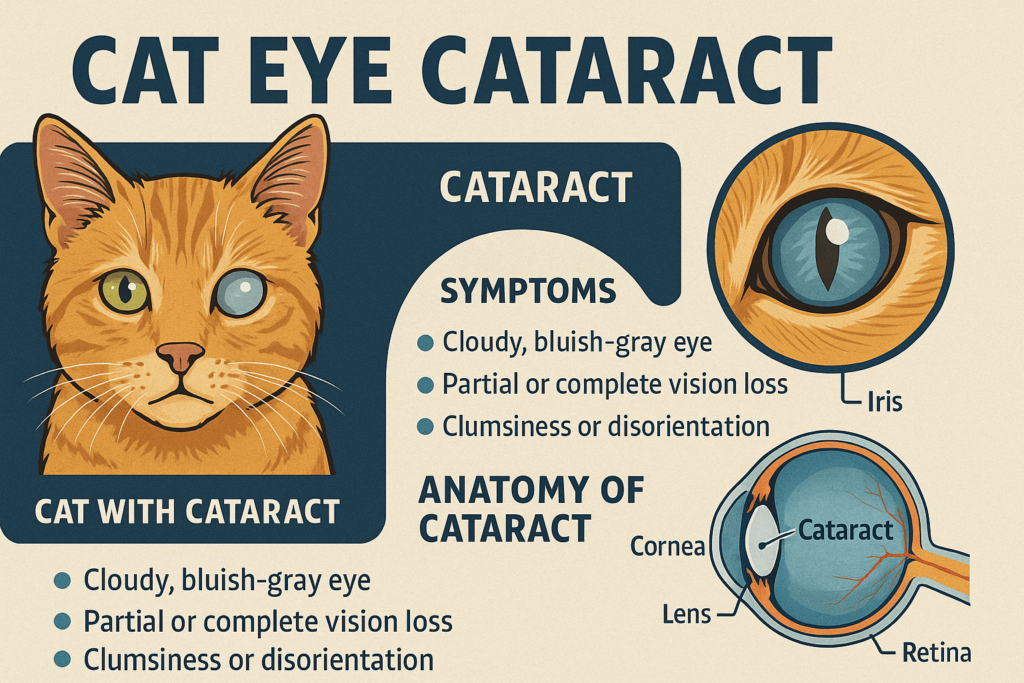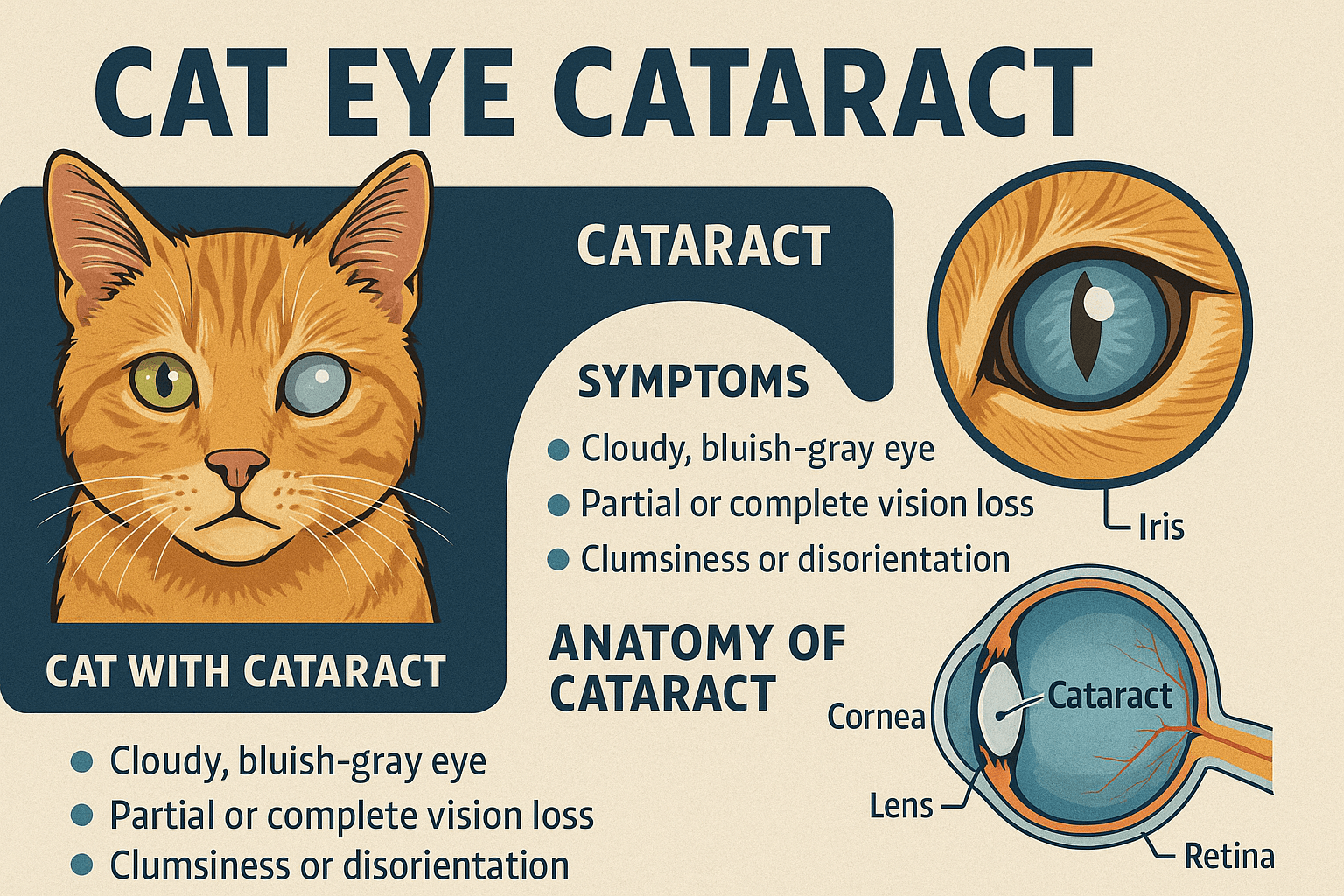Understanding Cat Eye Cataracts: Causes, Symptoms, and Care
Cataracts in cats are a condition that clouds the lens of the eye, leading to impaired vision or even blindness if left untreated. While cataracts are more commonly associated with aging humans and dogs, they can also affect our feline companions. Recognizing the signs early and understanding the underlying causes is crucial for ensuring your cat’s comfort and quality of life. Whether you’re a concerned pet owner or simply curious about feline eye health, this guide will provide comprehensive insights into cat eye cataracts, including prevention, treatment options, and how to support your furry friend through this challenge.
Expert Insight: The Role of Chronic Uveitis in Cat Eye Cataracts
“The most common cause of cataracts in cats is chronic uveitis. Uveitis is inflammation inside the eye that can result from an infection, disease, or trauma. Diseases like feline leukemia, feline immunodeficiency virus (FIV), feline infectious peritonitis (FIP), and toxoplasma gondii may increase a cat’s risk of having chronic uveitis and subsequent cataracts.”
Common Causes of Cat Eye Cataracts
Cataracts in cats can develop due to a variety of factors, ranging from genetic predispositions to underlying health conditions. Understanding these causes can help you take proactive steps to protect your cat’s vision.
Aging Process:
As cats grow older, the proteins in their eye lenses may break down, leading to cataract formation. This is a natural part of aging but should still be monitored closely.Diabetes Mellitus:
Cats with diabetes are at a higher risk of developing cataracts due to elevated blood sugar levels affecting the eyes’ delicate structures.Trauma or Injury:
Physical damage to the eye, such as scratches or blunt force, can result in inflammation that leads to cataract development.Genetic Predisposition:
Some breeds, like Himalayans and Persians, are more prone to hereditary cataracts, making regular eye check-ups essential.Infections or Inflammation:
Conditions like uveitis (inflammation of the eye) can increase the likelihood of cataracts forming over time.
By identifying potential causes early, you can work with your veterinarian to mitigate risks and preserve your cat’s eye health.

Signs and Symptoms of Cat Eye Cataracts
Detecting cataracts in their early stages is key to managing the condition effectively. Be vigilant about observing changes in your cat’s behavior or appearance that could indicate vision problems.
Cloudy or Bluish Eye Appearance:
A noticeable change in the transparency of your cat’s eye lens is one of the most common signs of cataracts.Difficulty Navigating Spaces:
Cats with cataracts may bump into furniture or hesitate to jump onto surfaces they previously navigated easily.Squinting or Excessive Blinking:
Discomfort or sensitivity to light often accompanies cataracts, causing your cat to squint or blink frequently.Changes in Behavior:
A cat with vision impairment may become less active, more clingy, or exhibit signs of confusion.Redness or Swelling Around the Eye:
Inflammation accompanying cataracts can cause visible redness or swelling, signaling the need for veterinary attention.
Recognizing these symptoms promptly allows you to seek professional care and explore treatment options before the condition worsens.
Check this guide 👉Understanding the Cat Light Spectrum: Best 7 Expert Tips!
Check this guide 👉Cat Eye Discharge Green: Best 7 Health Tips!
Check this guide 👉How to Clean a Cat Eye Infection: Best 7 Health Tips!
Preventive Measures for Cat Eye Cataracts | Treatment Options for Cat Eye Cataracts |
|---|---|
Regular veterinary eye check-ups | Surgical removal of cataracts |
Managing underlying health conditions | Anti-inflammatory medications |
Providing a balanced diet | Eye drops to reduce discomfort |
Protecting eyes from injuries | Monitoring progression with frequent exams |
Avoiding exposure to toxins | Lifestyle adjustments for blind cats |
How to Support a Cat with Cataracts
If your cat has been diagnosed with cataracts, there are several ways you can support them to ensure their comfort and well-being. These strategies focus on adapting their environment and maintaining their quality of life.
Create a Safe Space:
Remove obstacles and rearrange furniture to make navigation easier for your visually impaired cat.Use Consistent Routines:
Cats thrive on predictability—maintain consistent feeding, play, and sleeping schedules to reduce stress.Enhance Their Environment:
Use textured rugs or mats to help your cat identify safe zones and avoid slippery surfaces.Provide Auditory Cues:
Incorporate bells or sound-making toys to help your cat locate objects or follow you around the house.Monitor Their Health Regularly:
Schedule routine vet visits to track the progression of cataracts and address any new concerns promptly.
With thoughtful adjustments, you can help your cat adapt to vision challenges while continuing to live a happy, fulfilling life.
Myths and Misconceptions About Cat Eye Cataracts
There are many misconceptions surrounding cat eye cataracts that can lead to confusion or misinformation. Dispelling these myths helps ensure proper care and treatment.
Myth: Cataracts Only Affect Older Cats:
While age is a factor, younger cats can also develop cataracts due to trauma, infections, or genetic conditions.Myth: All Cloudy Eyes Are Cataracts:
Not all cloudy appearances indicate cataracts; conditions like nuclear sclerosis mimic similar symptoms but require different management.Myth: Cataracts Are Always Painful:
While advanced cataracts can cause discomfort, early-stage cataracts may not be painful and are manageable with treatment.Myth: Surgery Is Always Necessary:
Surgery is not required for every case—some cataracts can be managed with medication or lifestyle changes.Myth: Blind Cats Can’t Live Happily:
Many blind cats adapt remarkably well to their surroundings and continue to lead joyful lives with proper support.
Understanding the truth behind these myths ensures better care and reduces unnecessary worry for cat owners.
Tips for Preventing Eye Issues in Cats
Preventing eye issues in cats involves proactive care and attention to their overall health. These tips can help reduce the risk of cataracts and other eye-related problems.
Feed a Nutrient-Rich Diet:
Ensure your cat’s diet includes antioxidants like vitamins C and E, which support eye health.Keep Vaccinations Up-to-Date:
Vaccinating against infectious diseases reduces the risk of infections that could harm the eyes.Clean Their Eyes Regularly:
Gently wipe away discharge or debris from your cat’s eyes using a damp cloth to prevent irritation.Avoid Exposure to Harmful Substances:
Keep chemicals, smoke, and other irritants away from your cat’s environment.Schedule Routine Vet Visits:
Early detection of eye issues during regular check-ups can prevent complications down the line.
Taking these preventive steps lays the foundation for lifelong eye health and minimizes the chances of serious conditions like cataracts.
Coping Strategies for Blind Cats
If your cat loses vision due to cataracts, there are numerous ways to help them adjust and thrive despite their impairment. These coping strategies focus on creating a supportive environment.
Limit Furniture Rearrangements:
Keeping furniture in the same place helps blind cats navigate familiar spaces without confusion.Use Scent Markers:
Apply scented oils or sprays to key areas to help your cat identify important locations like food bowls or litter boxes.Encourage Gentle Play:
Engage your cat in low-impact activities like feather wand games to stimulate their remaining senses.Talk to Your Cat Often:
Your voice provides reassurance and helps your cat locate you within the home.Supervise Outdoor Time:
If your cat enjoys outdoor exploration, use a harness or leash to keep them safe while preventing accidents.
With patience and creativity, blind cats can enjoy a high quality of life filled with love and enrichment.
When to Seek Immediate Veterinary Help
While some eye issues in cats resolve on their own, others require urgent attention to prevent permanent damage. Knowing when to contact your vet is critical for protecting your cat’s vision.
Sudden Vision Loss:
If your cat appears disoriented or unable to see suddenly, seek immediate veterinary care.Severe Redness or Swelling:
Intense inflammation can indicate an infection or injury requiring prompt treatment.Excessive Tearing or Discharge:
Persistent tearing or unusual discharge may signal an underlying problem needing diagnosis.Pawing at the Eyes:
Constant pawing suggests discomfort or pain and warrants a vet visit to rule out serious conditions.Changes in Eye Color or Shape:
Noticeable alterations in the appearance of your cat’s eyes should never be ignored.
Acting quickly in these situations ensures timely intervention and improves the chances of a positive outcome for your cat’s eye health.
Frequently Asked Questions About Cat Eye Cataracts
What causes cataracts in cats?
Cataracts can result from aging, diabetes, trauma, genetics, or infections affecting the eye.
Can cataracts in cats be cured?
While surgery can remove cataracts, not all cases require intervention, and some can be managed with medications.
How do I know if my cat has cataracts?
Look for cloudy eyes, difficulty navigating spaces, squinting, or behavioral changes indicative of vision loss.
Is surgery safe for cats with cataracts?
Yes, when performed by a qualified veterinary ophthalmologist, cataract surgery is generally safe and effective.
Can I prevent cataracts in my cat?
While not all cataracts are preventable, maintaining good overall health and regular vet visits can reduce risks.
Prioritizing Your Cat’s Eye Health
Cat eye cataracts may seem daunting, but with awareness, vigilance, and proper care, you can help your feline friend maintain their quality of life. From understanding the causes and symptoms to exploring treatment options and supportive measures, every step you take contributes to your cat’s well-being. Remember, your veterinarian is your greatest ally in managing this condition, so don’t hesitate to seek professional guidance. By staying informed and attentive, you can ensure your cat continues to thrive, whether they’re navigating the world with perfect vision or adapting to new challenges.
Understanding Cryptosporidium in Cats: Best 7 Expert Tips! – Spot symptoms, treat safely, and stop parasite spread in your home.
Understanding Cryptosporidium in Dogs: Best 7 Expert Tips! – Learn symptoms, treatment & prevention for this stubborn gut parasite.
Understanding Syringomyelia in Cats: Best 7 Expert Tips! – Recognize signs, manage pain, and support your cat’s neurological health with vet-backed guidance.
Understanding Syringomyelia in Dogs: Best 7 Expert Tips! – Expert insights on symptoms, MRI diagnosis, pain management & quality of life.





